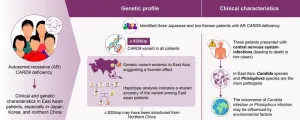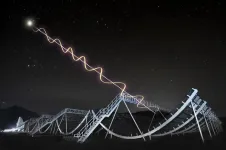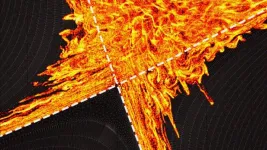(Press-News.org) The structure and function of the kidneys is altered by space flight, with galactic radiation causing permanent damage that would jeopardise any mission to Mars, according to a new study led by researchers from UCL.
The study, published in Nature Communications, is the largest analysis of kidney health in space flight to date and includes the first health dataset for commercial astronauts. It is published as part of a Nature special collection of papers on space and health.
Researchers have known that space flight causes certain health issues since the 1970s, in the years after humans first travelled beyond Earth’s magnetic field, most famously during the first moon landing in 1969. These issues include loss of bone mass, weakening of the heart and eyesight, and development of kidney stones.
It is thought that many of these issues stem from exposure to space radiation, such as solar winds from the Sun and Galactic Cosmic Radiation (GCR) from deep space, that the Earth’s magnetic field protects us from on Earth1. As most manned space flights take place in Low Earth orbit (LEO) and receive partial protection from Earth’s magnetic field, only the 24 people who have travelled to the moon have been exposed to unmitigated GCR and only for a short time (6-12 days).
Nobody has studied what changes might be happening in the kidneys and other organs as a result of conditions that would be experienced during space travel beyond Earth’s magnetic field over longer periods.
In this Wellcome, St Peters Trust and Kidney Research UK (KRUK) funded study, a UCL-led team of researchers from over 40 institutions across five continents conducted a range of experiments and analyses to investigate how the kidneys respond to space flight.
This included biomolecular, physiological and anatomical assessments using data and samples from 20 study cohorts. This included samples from over 40 Low Earth orbit space missions involving humans and mice, most of which were to the International Space Station, as well as 11 space simulations involving mice and rats.
Seven of these simulations involved mice exposed to simulated GCR doses equivalent to 1.5-year and 2.5-year Mars Missions, mimicking space flight beyond Earth’s magnetic field.
The results indicated that both human and animal kidneys are ‘remodelled’ by the conditions in space, with specific kidney tubules responsible for fine tuning calcium and salt balance showing signs of shrinkage after less than a month in space. Researchers say the likely cause of this is microgravity rather than GCR, though further research is required to determine if the interaction of microgravity and GCR can accelerate or worsen these structural changes.
The primary reason that kidney stones develop during space missions had previously been assumed to be solely due to microgravity-induced bone loss that leads to a build-up of calcium in the urine. Rather, the UCL team’s findings indicated that the way the kidneys process salts is fundamentally altered by space flight and likely a primary contributor to kidney stone formation.
Perhaps the most alarming finding, at least for any astronaut considering a three-year round trip to Mars, is that the kidneys of mice exposed to radiation simulating GCR for 2.5 years experienced permanent damage and loss of function.
Dr Keith Siew, first author of the study from the London Tubular Centre, based at the UCL Department of Renal Medicine, said: “We know what has happened to astronauts on the relatively short space missions conducted so far, in terms of an increase in health issues such as kidney stones. What we don’t know is why these issues occur, nor what is going to happen to astronauts on longer flights such as the proposed mission to Mars.
“If we don’t develop new ways to protect the kidneys, I’d say that while an astronaut could make it to Mars they might need dialysis on the way back. We know that the kidneys are late to show signs of radiation damage; by the time this becomes apparent it’s probably too late to prevent failure, which would be catastrophic for the mission’s chances of success.”
The authors say that though the results identify serious obstacles to a Mars mission, it is necessary to identify problems before solutions can be developed.
Professor Stephen B. Walsh, senior author of the study from the London Tubular Centre, UCL Department of Renal Medicine, said: “Our study highlights the fact that if you’re planning a space mission, kidneys really matter. You can’t protect them from galactic radiation using shielding, but as we learn more about renal biology it may be possible to develop technological or pharmaceutical measures to facilitate extended space travel.
“Any drugs developed for astronauts may also be beneficial here on Earth, for example by enabling cancer patients’ kidneys to tolerate higher doses of radiotherapy, the kidneys being one of the limiting factors in this regard.”
Though the study only describes what happens to the kidneys up to two and a half years, it is the most comprehensive data available for the time being.
Notes to Editors:
For more information, please contact:
Dr Matt Midgley
+44 (0)20 7679 9064
m.midgley@ucl.ac.uk
1 A year on the International Space Station (ISS), for example, exposes astronauts to a dose of radiation 50% higher than the five-year dose limit for nuclear energy workers. The Inspiration 4 private space mission, which flew above the ISS by 200km, exposed its crew to as much radiation as a nine-month stint on the ISS in just three days. A year on the surface of Mars would expose you to as much radiation as an eyewitness to the Hiroshima atomic bomb, and a three-year return mission to Mars is estimated to be six times that (or ~10,900 X-rays).
Publication:
Keith Siew et al. ‘Cosmic Kidney Disease: An integrated panomic, physiological and morphological study into spaceflight-induced renal dysfunction’ is published in Nature Communications and is strictly embargoed until Tuesday 11 June 2024 at 16:00 BST / 11:00 ET.
DOI: https://doi.org/10.1038/s41467-024-49212-1
About UCL – London’s Global University
UCL is a diverse global community of world-class academics, students, industry links, external partners, and alumni. Our powerful collective of individuals and institutions work together to explore new possibilities.
Since 1826, we have championed independent thought by attracting and nurturing the world's best minds. Our community of more than 50,000 students from 150 countries and over 16,000 staff pursues academic excellence, breaks boundaries and makes a positive impact on real world problems.
The Times and Sunday Times University of the Year 2024, we are consistently ranked among the top 10 universities in the world and are one of only a handful of institutions rated as having the strongest academic reputation and the broadest research impact.
We have a progressive and integrated approach to our teaching and research – championing innovation, creativity and cross-disciplinary working. We teach our students how to think, not what to think, and see them as partners, collaborators and contributors.
For almost 200 years, we are proud to have opened higher education to students from a wide range of backgrounds and to change the way we create and share knowledge.
We were the first in England to welcome women to university education and that courageous attitude and disruptive spirit is still alive today. We are UCL.
www.ucl.ac.uk | Follow @uclnews on Twitter | Read news at www.ucl.ac.uk/news/ | Listen to UCL podcasts on SoundCloud | View images on Flickr | Find out what’s on at UCL Minds
END
Would astronauts’ kidneys survive a roundtrip to Mars?
2024-06-11
ELSE PRESS RELEASES FROM THIS DATE:
Depressive symptoms may hasten memory decline in older people
2024-06-11
Depressive symptoms are linked to subsequent memory decline in older people, while poorer memory is also linked to an increase in depressive symptoms later on, according to a new study led by researchers at UCL and Brighton and Sussex Medical School.
The study, published in JAMA Network Open, looked at 16 years of longitudinal data from 8,268 adults in England with an average age of 64.
The researchers concluded that depression and memory were closely interrelated, with both seeming to affect each other.
Senior author Dr Dorina Cadar, of the UCL Department of Behavioural Science & Health and Brighton and Sussex Medical School, said: “It is ...
New technique could help build quantum computers of the future
2024-06-11
Quantum computers have the potential to solve complex problems in human health, drug discovery, and artificial intelligence millions of times faster than some of the world’s fastest supercomputers. A network of quantum computers could advance these discoveries even faster. But before that can happen, the computer industry will need a reliable way to string together billions of qubits – or quantum bits – with atomic precision.
Connecting qubits, however, has been challenging for the research community. Some methods form qubits by placing ...
Trash-sorting robot mimics complex human sense of touch
2024-06-11
WASHINGTON, June 11, 2024 – Today’s intelligent robots can accurately recognize many objects through vision and touch. Tactile information, obtained through sensors, along with machine learning algorithms, enables robots to identify objects previously handled.
However, sensing is often confused when presented with objects similar in size and shape, or objects unknown to the robot. Other factors restrictive to robot perception include background noise and the same type of object with different shapes and sizes.
In Applied Physics Reviews, by AIP Publishing, researchers from Tsinghua University worked to break through the difficulties ...
Shedding light on the origin of a genetic variant underlying fungal infections
2024-06-11
Researchers from Japan uncover the genetic diversity and regional patterns of CARD9 deficiency in patients susceptible to fungal diseases
Tokyo, Japan – Fungal infections pose life-threatening risks, especially when vital organs or the central nervous system are affected. Individuals harboring variants in the CARD9 gene are particularly susceptible to invasive fungal infections, given that the protein coded by this gene serves as a critical regulator of the immune system. A recent discovery ...
Humanitarian organizations showed flexibility and grit during COVID supply chain disruptions: study
2024-06-11
When the COVID-19 pandemic hit, it sent shock waves across global supply chains. But manufacturers and other businesses weren’t the only ones hit hard: local and international aid organizations, tasked with providing humanitarian assistance during times of crisis, suddenly had a major crisis of their own. How would they get the supplies they needed to carry out their crucial work?
According to a new study by the UBC Sauder School of Business, the organizations showed remarkable nimbleness and ingenuity — and while the pandemic was an unusual event, their approaches can provide powerful insights ...
Research on the visual rabbit illusion takes a leap forward
2024-06-11
Fukuoka, Japan—Researchers from Kyushu University have uncovered new variations to a traditional illusion, based on how we perceive the motion of flashing lights. Published on May 21 in i-Perception, the findings show that when three light flashes are presented in rapid succession in our side vision, our brain tends to perceive them in a straight line, with the second flash around the midpoint, no matter the actual location of the second flash. This research, which earned the journal’s Early Career Best Paper Prize this year, offers new perspectives on perceptual errors ...
Virus-like nanoparticles control the multicellular organization and reproduction of host bacteria
2024-06-11
Tsukuba, Japan—Viruses are ubiquitous in the environment, and organisms have developed various mechanisms to counter their threat. However, the genome of actinomycetes contains a highly conserved gene set encoding virus-like nanoparticles, although its biological significance has remained unclear.
In this study, researchers examined Streptomyces davawensis, an actinomycete species, and discovered that it produces virus-like particles that facilitate host reproduction. Extracellular DNA, which serves as a scaffold for multicellular organization, was significantly reduced in the colonies of mutant S. davawensis strains ...
Origins of fast radio bursts come into focus through polarized light
2024-06-11
TORONTO, ON, June 11, 2024 — What scientists previously thought about where Fast Radio Bursts (FRBs) come from is just the tip of the iceberg, according to new research led by astronomers at the University of Toronto. The mysteries of the millisecond-long cosmic explosions are unfolding with a new way of analyzing data from the Canadian Hydrogen Intensity Mapping Experiment (CHIME).
Published today in The Astrophysical Journal, the study details the properties of polarized light from 128 non-repeating FRBs — those from sources that have ...
Press registration opens for ACS Fall 2024
2024-06-11
WASHINGTON, June 11, 2024 — Journalists who register for the fall meeting of the American Chemical Society (ACS) will have access to about 10,000 presentations on topics including agriculture and food, energy and fuels, health and medicine, sustainability, and more. ACS Fall 2024 is a hybrid meeting being held virtually and in person in Denver on Aug. 18-22, with the theme “Elevating Chemistry.”
ACS considers requests for press credentials and complimentary meeting registration from reporters (staff and freelance) and public information officers at government, nonprofit and educational institutions. Please ...
New plasma escape mechanism could protect fusion vessels from excessive heat
2024-06-11
The furious exhaust heat generated by a fusing plasma in a commercial-scale reactor may not be as damaging to the vessel’s innards as once thought, according to researchers at the U.S. Department of Energy’s (DOE) Princeton Plasma Physics Laboratory (PPPL), Oak Ridge National Laboratory and the ITER Organization (ITER).
“This discovery fundamentally changes how we think about the way heat and particles travel between two critically important regions at the edge of a plasma during fusion,” said PPPL Managing Principal Research Physicist Choongseok Chang, who led ...





